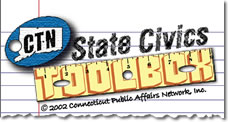|
|
CT-N Legislative Session Click Here for the Word Document version of this page. |
Video Session: Use an appropriate taped CT-N session
of the Connecticut House of Representatives or Senate discussing a bill
with clearly defined party arguments. Check our
Hot Topics page for ideas.
Common Core State Standards:
R3: Identify key steps
in a text’s description of a process related to history/social studies
(e.g., how a bill becomes a law, how interest rates are raised or
lowered).
R7: Integrate visual information (e.g. in charts, graphs,
photographs, videos or maps) with other information in print and digital
texts.
Content: Students learn about the
three branches of government and find out how the three
branches interact with each another. Students will role-play each
branch’s responsibility in the law-making process.
Additional Materials Needed:
- How a Bill Becomes a Law
- How a Bill Becomes a Law in Connecticut
- Computers, Internet access
- Poster paper/markers
ADDITIONAL RESOURCES (SEARCH SITES)
- Gale U.S. History in Context database (if available)
- ICONN database (if available)
- Bill of Rights Institute
- First Amendment Center
- Annenberg Classroom
Class Time: Three class periods.
Objectives: Students will: model the roles of each of the three branches
of government, identify the main role and function of each of the three
branches, read and understand a bill and explain how it became a law.
Activity:
- Prior to class, students should engage in learning activities where they identify the roles and responsibilities of each branch of government and also understand the system of checks and balances.
- (Day One) For homework the night before the lesson, students should read the poster/handout “How a Bill Becomes a Law” and bring it with them to class. Begin the class the next day by reviewing the process of how a bill becomes a law.
- Divide the class into three groups and assign each group a branch of government. Have students briefly review their roles and responsibilities as a branch.
- Introduce topic of your choice to class by showing a selected clip of legislative debate. Have the class take notes on what is happening and being discussed during the debate.
- After viewing the debates, initiate a discussion about the
topic. Discuss the arguments for and against this bill becoming a
law.
- (Day Two) In a computer lab, have students log on to http://thomas.loc.gov/home/thomas.php. Instruct students to research the topic they viewed in class the day before and find a comparable bill. Students should refer to the CRS Summary in order to get the general idea of the particular bill. Students should print this summary and return to their branch of government group.
- In their branch of government groups, student should select one
bill they will focus on (each student will bring back a bill, they
should only choose one). Using the bill, students will create a
poster explaining how their branch of government will deal with this
bill in the process of it becoming a law.
- (Day Three) In their branch of government groups, students in each group will explain the bill that they chose and use their poster to explain how their branch of government would deal with this bill in the process of it becoming a law. They will cite specific roles and responsibilities of their branch of government in this process.
Teacher Note: If time is available, students
can choose to present their information in a different format besides a
poster, i.e. Prezi, Glogster, PowerPoint, etc.
Debrief/Closure: Bring the class together as a whole and
discuss the following key issues/ questions:
- Based on the research and work you have completed, is one branch more powerful than any other?
- Why is it important to have a system of checks and balances?
- Why can the law-making process take such a long time?
If you have any comments or suggestions about this activity or would like to submit your own activity, please contact me and share your ideas.
